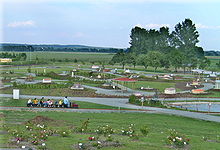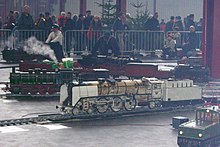Garden railway
A garden railroad is a model railroad that is set up either permanently or in a removable manner outdoors as a model railroad system and is usually suitable for transporting people . The passengers are usually transported seated on the vehicles . The model track widths of 127 mm (5 inches ) and 184 mm (7¼ inches) are widely used .
The garden railways as well as the garden model railways are standardized in the standards of European model railways (NEM), but not the park railways .
Disambiguation
Garden railway as a model railway
In the case of garden railways that are not suitable for passenger transport, the focus is on operating as a model railroad. For operational reasons, model railways of nominal size 0 or larger, with 0, 0m and 0e gauges, are mainly used. In this regard, garden railroad systems of gauge G, G for garden railroad are widely used. When reproducing to scale in track G in 1: 22.5, one also speaks of track IIm , where the "m" stands for meter track, the model of which is being reproduced.
Similar tracks
In addition to garden railways, there are other railways with comparably small gauges. Park railways , Liliput railways and, in the countries of the former Eastern Bloc, pioneer railways are passenger-carrying railways in mostly publicly accessible green spaces and amusement parks. They mostly run on gauges of 15 inches (381 mm) and more, in Great Britain 10.25 inches (260 mm) and more, with pioneer railways 600 mm is widespread. As a rule, passengers are transported seated in the vehicles. From an international perspective, especially in the United Kingdom , there are narrow-gauge railways with gauges of the same order of magnitude, but they have a function in local public transport and transport passengers according to a timetable and at relatively high speeds over comparatively long distances, for example the over 20 km long Romney, Hythe and Dymchurch Railway to 15 inches.
In the case of transport tracks such as field tracks, peat tracks, mine tracks or brickworks, a track width of 600 mm is very common. While many of them also transport passengers, mostly company employees such as miners, in the mine, they are usually primarily used for internal freight transport. Today garden and park railways are partly built from historical transport rail material. Some rides, such as ghost trains, children's trains or roller coasters, are also built on a comparable scale, but differ greatly in technology and operation from the railways described above.
General

The tracks , the vehicle fleet as well as the accessories for garden railways must be robust and insensitive to the weather. This results in a certain minimum size in terms of scale or gauge .
A garden railroad that transports people is also designed so that it can transport people. This presupposes a certain strength and stability. Since the development of such railways originated mainly in Great Britain, gauge is traditionally given in inches . In addition, the scale is often given for the vehicle models.
| Track (NEM) |
Gauge | Scale for example as | ||||
|---|---|---|---|---|---|---|
| inch | mm | Standard gauge (1250–1700 mm) |
Narrow gauge (850–1250 mm) |
Narrow gauge (650–850 mm) |
Light rail (400–650 mm) |
|
| III | 3½ inches | 89 mm | 1:16 | 1:11 | 1: 8 | 1: 5.5 |
| V | 5 inches | 127 mm | 1:11 | 1: 8 | 1: 5.5 | 1: 4 |
| VII | 7¼ in | 184 mm | 1: 8 | 1: 5.5 | 1: 4 | 1: 3.3 |
| 7½ inches | 190 mm | 1: 7.5 / 1: 8 | 1: 5 | 1: 3 | ||
| X | 10¼ in | 260 mm | 1: 5.5 | |||
Garden railways with a gauge of 5 and 7¼ inches (Europe) or 7½ inches (USA, Canada) are the most common. In contrast to other model railways, however, no particular weight is attached to the question of scale. It is not uncommon for both 1: 8 and 1: 4 scale vehicles to be operated together on a 7¼-inch route.
Due to the large scale of garden railways, real steam models are often found here. There are also many locomotives with prototypical internal combustion engine drives (mostly diesel-hydraulic). The vast majority, however, have an electric drive. With the latter, the traction current is not supplied via the track or the overhead line , as is the case with model railways , but is usually obtained from accumulators that are carried along .
Plant types
Garden railways often consist of a circuit, where you can only get on and off at a single station. They can be roughly divided into two types, whereby the assignment to a category depends primarily on the structural effort and the integration into a garden landscape.
Fixed system integrated into a garden
Mostly in a green, park-like garden landscape, lavishly integrated garden railway system. High and low, flowering and non-flowering plantings are combined with the tracks, tunnels, bridges, lakes and structures to form a harmonious landscape. The planning of the track systems and the garden design are coordinated. The maintenance of the system and the care of the garden are usually time-consuming.
Railways with a gauge of less than 5 inches are often designed on elevated platforms . The passengers' feet are below the rail level, mostly on special steps on the passenger car. This allows you to keep your balance on such a narrow track. In Great Britain there are also different 5 and 7 inch tracks in this construction.
Temporary or mobile system, systems separated (isolated) from the garden
Temporary or mobile garden railroad systems are created on tracks that are laid with simple means, with little or no landscape. Garden railroad systems of this type often have exposed aggregate concrete slabs, an asphalt surface or just the lawn as the substrate. Such systems can also be found at exhibitions and trade fairs with materials that are easy to assemble and dismantle. The maintenance is usually minimal. Occasionally, garden railways can also be found that pull from event to event as a ride .
Sponsorship
Publicly accessible facilities are usually owned by museums, associations, foundations or companies, but there are also purely private facilities. While the facility is usually owned by the sponsor, the rolling stock is often privately owned by the club members. Depending on the space available, this is removed from the system after each day of travel. Guest drivers, i.e. owners of their own vehicles who come with this for a day, are usually welcome. Registration is usually not necessary, but is recommended.
To meet
Most of the facilities hold annual meetings at which guest drivers sometimes come from a long distance and with extensive material. A highlight is the annual steam festival in the Swiss Vapeur Parc in Le Bouveret. This festival serves as an exchange between the manageable garden railroad scene and is a special experience for every garden railroad fan. The Swiss Vapeur Parc is currently the largest amusement park in Switzerland when it comes to garden railways and houses one of the two cog railway routes that exist in Switzerland with a track width of 7 1 ⁄ 4 inches.
With 500 exhibitors and over 20,000 visitors (2014) , the real steam meeting in Karlsruhe , which takes place annually in January, is the world's largest meeting for steam and garden railroad fans. A complete exhibition hall is filled with a combined 5- / 7 1 ⁄ 4- inch system with a total length of around 5 km. The real steam meeting in Cologne is also organized by Messe Sinsheim as part of the international model building exhibition at the beginning of November. In 2004 z. B. with a combined Ⅴ- / Spur-track system with a length of 2.2 km. As part of the model railway experience in Dresden in spring, a 5-inch system with a length of 550 m (2014) has also been available since 2011.
At all meetings there is regularly the possibility for guest drivers to take part with their own vehicles after prior notification.
List of garden railways
Web links
Individual evidence
- ↑ NEM 010 standards, nominal sizes, gauges. (PDF) MOROP , 2011, accessed on September 26, 2014 .
- ↑ Real steam hall meeting. Retrieved September 26, 2014 .
- ↑ Real steam meeting is pure steam modeling. (No longer available online.) November 7, 2006, archived from the original on October 6, 2014 ; Retrieved September 26, 2014 . Info: The archive link was inserted automatically and has not yet been checked. Please check the original and archive link according to the instructions and then remove this notice.


